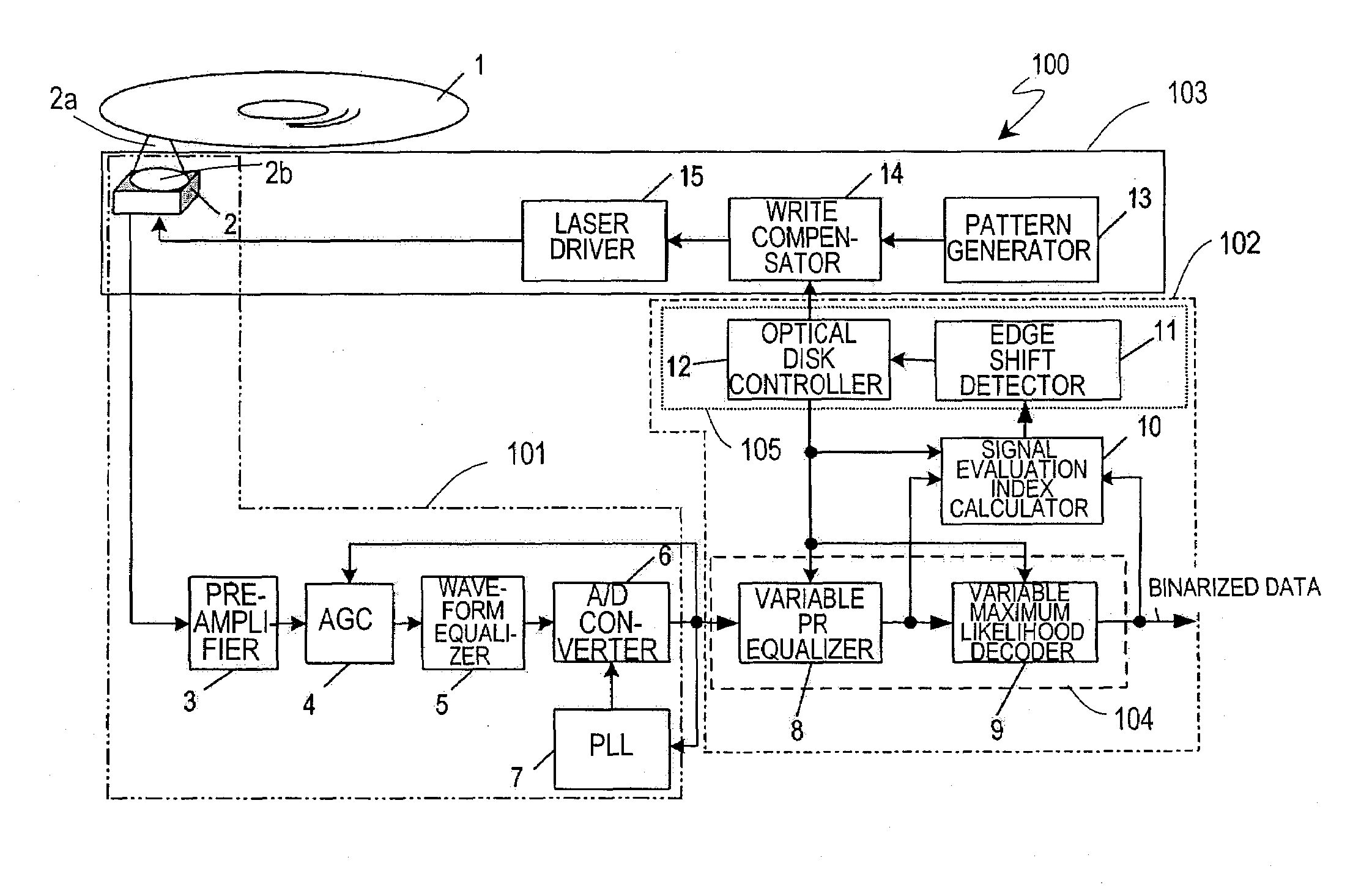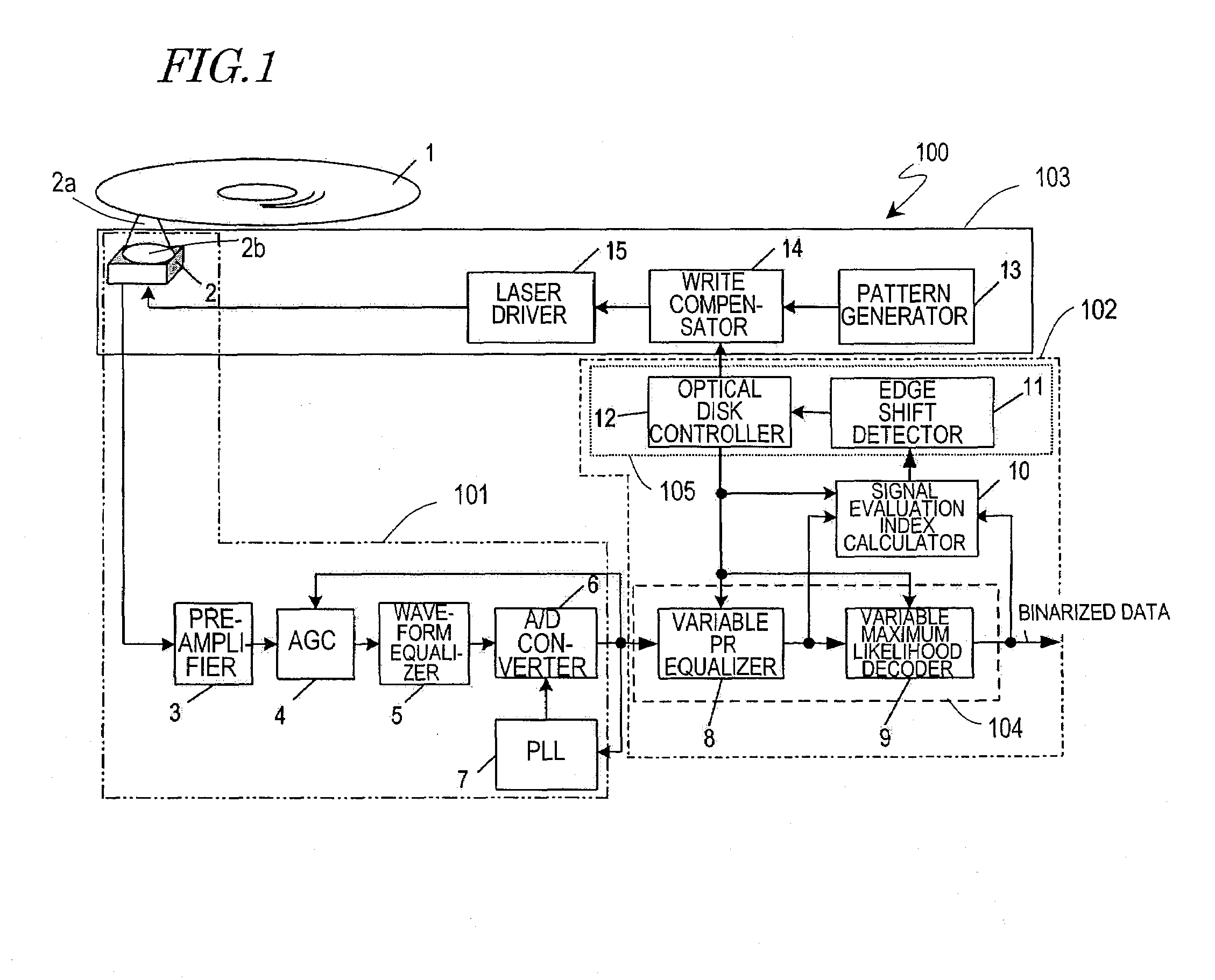Information recording medium evaluation method, information recording medium, method for manufacturing information recording medium, signal processing method and access control apparatus
a technology of information recording medium and evaluation method, which is applied in the direction of recording signal processing, digital signal error detection/correction, instruments, etc., can solve the problems of increasing intersymbol interference, increasing snr (signal to noise ratio), and increasing snr (signal to noise ratio). , to achieve the effect of maximizing system margin, ensuring stability, and ensuring quality of read signal
- Summary
- Abstract
- Description
- Claims
- Application Information
AI Technical Summary
Benefits of technology
Problems solved by technology
Method used
Image
Examples
embodiment 1
[0106]Hereinafter, a preferred embodiment of an optical disk drive according to the present invention will be described with reference to FIG. 1, which illustrates an optical disk drive 100 as a first specific preferred embodiment of the present invention.
[0107]The information recording medium 1 shown in FIG. 1 is used to read and write information optically from / on it and may be an optical disk medium, for example. The optical disk drive 100 is a read / write system for reading and writing information from / on the given information recording medium 1.
[0108]The optical disk drive 100 includes a read section 101, a write condition modifying section 102 and a write section 103.
[0109]The read section 101 includes an optical head 2, a preamplifier 3, an automatic gain controller (AGC) 4, a waveform equalizer 5, an A / D converter 6 and a PLL 7. The read section 101 generates a digital signal based on an analog signal representing information that has been read from the information recording ...
embodiment 2
[0151]FIG. 12 shows a configuration for an optical disk drive 300 as a second specific preferred embodiment of the present invention. The optical disk drive 300 has the same configuration as the optical disk drive 100 shown in FIG. 1 except that the write condition modifying section 102 includes different components.
[0152]The signal evaluation index calculator 10 of this optical disk drive 300 calculates and detects evaluation indices for the patterns shown in respective Tables 1, 2 and 3. That is to say, by calculating those evaluation indices, the signal evaluation index calculator 10 detects the values of those evaluation indices. The optical disk drive 300 further includes a selector 17, which determines which of these results of calculations (and detections) should be output to the optical disk controller 12.
[0153]In response to the control signal supplied from the optical disk controller 12, the selector 17 determines which of the patterns shown in Tables 1 to 3 should be outp...
embodiment 3
[0180]Next, an information recording medium will be described as a third preferred embodiment of the present invention. FIG. 16 illustrates an information recording medium 1 according to this preferred embodiment. The information recording medium 1 is supposed to be loaded into the optical disk drive 100, 200 or 300 described above.
[0181]FIG. 16 illustrates a multilayer phase-change type thin film disk medium as an exemplary information recording medium 1. However, the recording medium may also be a single layer disk medium with only one recording layer. The information recording medium 1 shown in FIG. 16 includes a number n (which is an integer that is equal to or greater than two) of recording layers. The information recording medium 1 includes a coating layer (protective coating) 162, recording layers Ln through L0, and a polycarbonate substrate 161, which are stacked in this order over the light source of a laser beam 2a (see FIG. 1). Also, between each pair of adjacent recordin...
PUM
| Property | Measurement | Unit |
|---|---|---|
| wavelength | aaaaa | aaaaa |
| wavelength | aaaaa | aaaaa |
| thickness | aaaaa | aaaaa |
Abstract
Description
Claims
Application Information
 Login to View More
Login to View More - R&D
- Intellectual Property
- Life Sciences
- Materials
- Tech Scout
- Unparalleled Data Quality
- Higher Quality Content
- 60% Fewer Hallucinations
Browse by: Latest US Patents, China's latest patents, Technical Efficacy Thesaurus, Application Domain, Technology Topic, Popular Technical Reports.
© 2025 PatSnap. All rights reserved.Legal|Privacy policy|Modern Slavery Act Transparency Statement|Sitemap|About US| Contact US: help@patsnap.com



